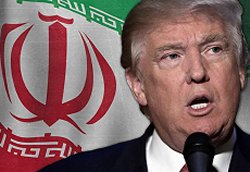
|
- Iran: Eight Prisoners Hanged on Drug Charges
- Daughter of late Iranian president jailed for ‘spreading lies’ - IRAN: Annual report on the death penalty 2016 - Taheri Facing the Death Penalty Again - Dedicated team seeking return of missing agent in Iran - Iran Arrests 2, Seizes Bibles During Catholic Crackdown
- Trump to welcome Netanyahu as Palestinians fear U.S. shift
- Details of Iran nuclear deal still secret as US-Tehran relations unravel - Will Trump's Next Iran Sanctions Target China's Banks? - Don’t ‘tear up’ the Iran deal. Let it fail on its own. - Iran Has Changed, But For The Worse - Iran nuclear deal ‘on life support,’ Priebus says
- Female Activist Criticizes Rouhani’s Failure to Protect Citizens
- Iran’s 1st female bodybuilder tells her story - Iranian lady becomes a Dollar Millionaire on Valentine’s Day - Two women arrested after being filmed riding motorbike in Iran - 43,000 Cases of Child Marriage in Iran - Woman Investigating Clinton Foundation Child Trafficking KILLED!
- Senior Senators, ex-US officials urge firm policy on Iran
- In backing Syria's Assad, Russia looks to outdo Iran - Six out of 10 People in France ‘Don’t Feel Safe Anywhere’ - The liberal narrative is in denial about Iran - Netanyahu urges Putin to block Iranian power corridor - Iran Poses ‘Greatest Long Term Threat’ To Mid-East Security |
Sunday 22 January 2012Ayatollahs' Democracy: An Iranian Challenge by H. Majd
The Observer -- "She probably felt that Iran's form of democracy allowed her certain latitudes," Hooman Majd teased a censorious Iranian official regarding the questionable imprisonment for espionage, in early 2009, of the Iranian-American journalist Roxana Saberi. Majd hints that this is the way to get sweetness from the Islamic Republic: criticise, if you must, through flattery. Majd is a high-profile explainer of the Iranian regime to American audiences, and his contribution is novel because he does not, like most Iranian-American analysts, wish to end theocracy. Decades ago, he honed his polemical skills by defending the nascent Islamic Republic to Iranian emigres at Speakers' Corner in London. His books are worth reading because they offer acute, almost "insider" analyses of Iranian policies and intra-regime rivalries. A relative by marriage of Mohammad Khatami, Iran's president from 1997-2005, Majd is a sometimes sympathetic communicator of the regime's positions, and an enthusiast only for its most loyal oppositionists. In The Ayatollahs' Democracy, his account of events surrounding Iran's 2009 opposition green movement, Majd emphasises how far some Iranians hoped reform within the system might be pushed. He concedes that Iran's 2009 "election" fielded only regime-vetted candidates and was stolen, and that the reigning administration is "increasingly fascistic". Yet he deems the Ayatollah Khomeini's Islamist project of 1979, at least according to "many Iranians", an "experiment" that requires "reform" to "reach the utopia" to which it aspired. His Islamic Republic is flawed, capricious, but also popular, and a bulwark of sovereignty. Majd's mild reformist agenda requires him to fight on two fronts, and his book is as much an effort in damage control as it is a pro-green tract. Many greens demonstrated much stronger appetites than their "leaders", and took greater risks, enduring rape, disease, and death in government torture chambers. Yet Majd insists the protests were an establishment movement, that the opposition candidate Mehdi Karroubi was a "spoiler", and that anyone who saw in demonstrations a rejection of theocracy harmed the cause. The opinions of Iranians born after 1979 – the majority of the population – are scarce in his account. In splitting his differences with Iran's rulers, his language falls prey to Orwellian coinages, as when he insists on "marginal equality" for all religious minorities. His reference in his final chapter to 2009's "disturbances", and his likening of violence against protesters to that endured by government forces, compares unenviably with the rhetoric of yesteryear's "reformers," Saif Gaddafi and Bashar al-Assad. At its best, Majd's approach evokes ketman, the ancient Persian principle of dissimulation before a powerful foe. But, though the tactic commends itself to people wary of revolutionary violence, the green movement failed, in part, because Iran's hardliners were hip to the concept: they knew that ketman was once taken up by forces of resistance in eastern Europe, and, as Majd points out, were quick to warn one another of "velvet revolution". Thus, the greens never found a true leader, and the regime pursued its own version of ketman in its international brinkmanship, successfully changing the subject from its war on Iranian civil society to the foreigners' plot against the regime. |






